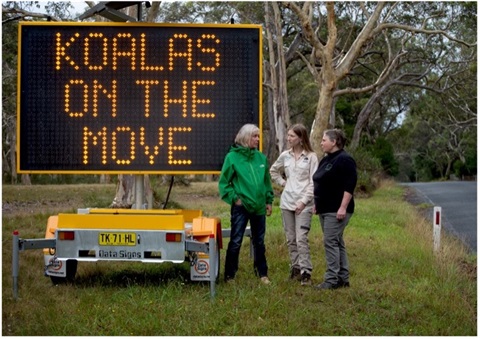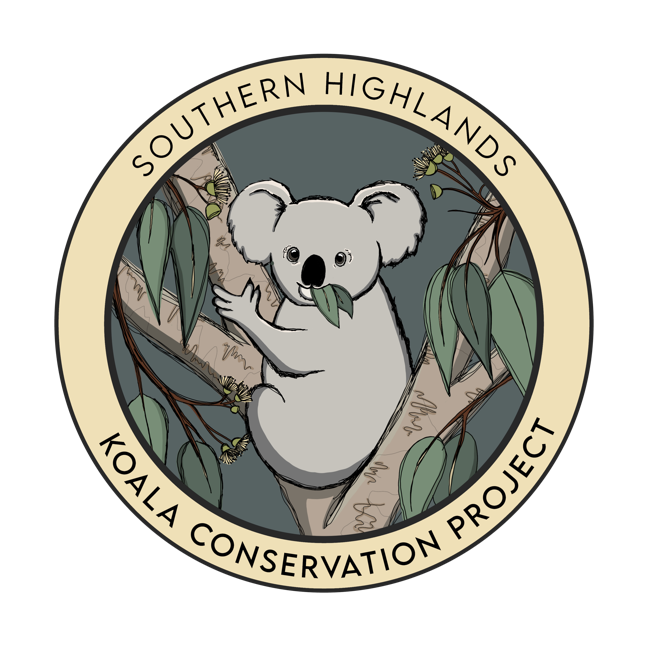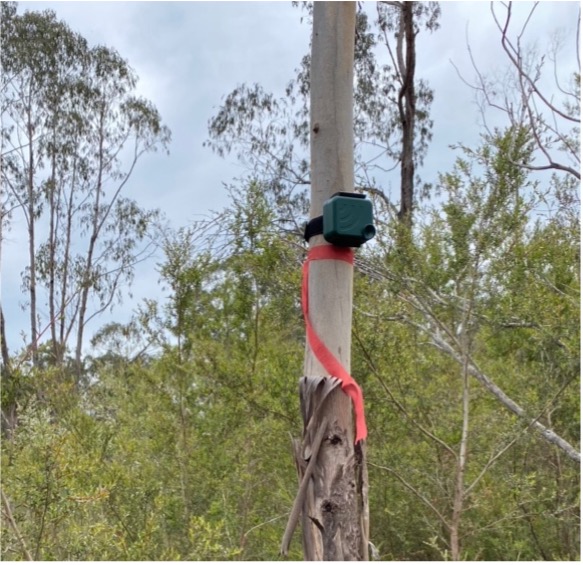Southern Highlands Koala Conservation Project

Koalas (Guula) in the Southern Highlands
The Southern Highlands is home to an estimated 3,000 – 4, 000 koalas. The Southern Highlands has a long history with koalas: the Gundungurra Traditional Owners call koalas “Guula” and Dharawal Traditional Owners call koalas “Garilwa”.
The first recorded sighting of a koala by a European was in Bargo in 1798 and over the next century the Southern Highlands koala population virtually disappeared, due to a deadly combination of habitat clearing, hunting for the fur trade, and drought.
The Southern Highlands Koala Conservation Project (SHKCP) was established in 2014 following the Hall Road Bushfire. Since then, it has been working to ensure that our koalas are surviving and thriving in the wild.
The SHKCP is considered an exemplar for other regions for the long-term protection of the largest population of koalas in southern NSW. What was the least understood koala population is now one of the best understood – a key goal of this highly successful project.
There are 10 koala strongholds listed in the NSW Koala Strategy where experts have identified important koala populations that will benefit from more intensive investment and actions. The Southern Highlands has two listed koala stronghold populations – one in the East and one in the West.
Years of data collection and survey effort under the project has revealed that our two stronghold populations have different population densities, home ranges and preferred tree species.
The project is addressing six main issues to protect koalas and their habitat in the long term:
- Private land conservation
- Habitat restoration
- Fire management
- Roadkill
- Population monitoring
- Supporting koala carers
 SHKCP logo
SHKCP logo
The SHKCP is proudly supported by the NSW Government’s NSW Koala Strategy and Wingecarribee Shire Council’s Environment Levy.
Council has been instrumental in developing this project in partnership with other agencies including the NSW Department of Planning and Environment (DPE), the University of Sydney and the NSW Biodiversity Conservation Trust (BCT).
Visit the Southern Highlands Koala Country web page for more information about the NSW Koala Strategy Southern Highlands regional partnership, or watch this video.
Learn more about the work we’re doing in the Southern Highlands to save this iconic Australian animal by following our SHKCP project page on Facebook.
Follow SHKCP on Facebook
Project outcomes
Habitat conservation and restoration
- Expansion of the Land for Wildlife network with over 200 active properties and over 5,500 ha being managed for conservation.
- Over 4,500 koala habitat trees (local provenance) given away to Land for Wildlife properties to create new habitat (approximately 30 ha of habitat reconstruction).
- Over 2,579 ha over 7 privately-owned properties in permanent conservation agreements in Wingecarribee Shire with over $28m invested (NSW BCT – Conservation Tender 11).
- Working towards a target of 50 ha of restored habitat on private land by June 2024.
- 10,000+ koala habitat trees planted to create new habitat (85 ha) at Guula Ngurra National Park.
- Chemical training (ChemCert) offered to local First Nations people to assist with restoring koala habitat on Country at Guula Ngurra National Park.
- Collaborating with other agencies on koala habitat restoration projects to improve outcomes for Southern Highlands koalas.
- Another 27 vegetation surveys completed to contribute to vegetation mapping for the Southern Highlands.
Support for local communities to conserve koalas
- Providing citizen science opportunities for the community to record koala sightings online.
- Creation and involvement of a public land management inter-agency working group to exchange ideas and collaborate on conservation programs and projects. Member organisations include DPE, NPWS, WaterNSW, ForestryCorp, NSW BCT, South East Local Land Services, Wingecarribee Shire Council and Wollondilly Shire Council.
- Supporting landholders with ecological assessments and land management advice through Land for Wildlife.
- Promoting the use of the Koala Smart program in primary and secondary schools across the Southern Highlands.
- Supporting the Flora Reserve Working Group to achieve better conservation outcomes in the new Jellore, Belanglo and Meryla Flora Reserves.
- Working with indigenous stakeholders to deliver on-ground outcomes including weed control and revegetation.
- Delivery of multiple workshops, celebratory events, education resources and newsletters e.g., Koalarama workshop series.
- Partnering with other providers (Rivers of Carbon, South East Local Land Services, and Greening Australia) to deliver better conservation outcomes for koalas including facilitating private land conservation working group meetings
Improved health and safety of koalas
- Supporting wildlife carers to provide the best possible care to injured or sick koalas.
- Facilitating workshops across all care organisations to improve care standards and outcomes.
- Supporting improved fire management to better protect koalas and their habitat.
- Identifying priority areas for vehicle-strike minimisation initiatives.
- Development of a vehicle-strike minimisation and monitoring plan for priority roads including Tourist Road.
- Deployment of roadside variable message signs to improve driver awareness on roads that intersect core koala habitat.
Building of local knowledge of koalas
- Facilitating community-led sightings of koalas.
- Establishing a methodology for long-term koala monitoring.
- Supporting state-wide baseline monitoring of koalas.
- Contributing to collection of genetic samples.
- Delivery of Koala Karaoke bioacoustics monitoring programs in 2020, 2021 and 2022 where naive occupancy was estimated to be 23 per cent, 30 per cent and 17 per cent respectively. This involved the deployment and retrieval of 125 (2020), 135 (2021) and 141 (2022) AudioMoths in accessible and remote bushland across the Shire.
- A third year of monitoring is planned for 2023, including a Koala Karaoke: Citizen Science Edition targeting habitat on private land in the west of the Shire.
Koala Karaoke bioacoustic monitoring program
 A Koala Karaoke microphone attached to a tree.
A Koala Karaoke microphone attached to a tree.
Wingecarribee Shire Council developed the Koala Karaoke program in 2020 in partnership with the NSW Department of Planning and Environment.
The program involves putting out microphones all over the Southern Highlands to record koala bellows in the breeding season. Male koalas bellow from September to February to attract females and scare off other males.
These records of koala bellows tell us where koalas are in the Southern Highlands, and we look at which environmental variables might be influencing koala occupancy. Each annual survey produces over 10,000 hours of audio.
Never heard a koala bellow?
Listen to the roar of the bush
Koala habitat in the Southern Highlands
Koala habitat includes any eucalypt dominated forest or woodland in the Southern Highlands. This is because koalas tend to feed primarily on eucalypts, but they may use non-eucalypt trees and shrubs for food and shelter.
Expanding and enhancing koala habitat is a big focus of the Southern Highlands Koala Conservation Project. Koala habitat in parts of the Southern Highlands is severely fragmented.
Creating new habitat in the form of paddock trees, fence line plantings, steppingstone plantings or even windbreaks help connect patches of koala habitat and facilitate koala movement throughout the landscape.
Contact your local native nursery or citizen.science@wsc.nsw.gov.au for information about sourcing local species for your property, or read the Department of Planning and Environment's Koala habitat restoration guidelines.
Koala habitat restoration guidelines: A practical guide to identify, connect and restore koala habitat in New South Wales
Local koala food trees
Did you know Southern Highlands koalas eat at least 23 species of eucalypts?
These species can be found across the Highlands, and planting locally occurring koala feed trees is a great way to support your local koala population.
Help us find koalas
Koalas are notoriously hard to find because they are so good at camouflaging into the tree canopy, but our research shows that almost all bushland in the Southern Highlands is koala habitat.
You can help our local koalas by searching for koala scat at the base of trees, looking for koala scratchings on tree trunks (double parallel claw marks), and going for a spotlight walk at night (you scan for eye shine with a torch!).
If you want to see koalas in the Southern Highlands, we recommend that you try your luck at:
If you do see a koala, please report it to the Southern Highlands Koala Conservation Project:
Koala Spotter App
Koala Hotline: 02 4868 0888
Email: citizen.science@wsc.nsw.gov.au
How can you help koalas?
Join a koala conservation program
Apply for a Biodiversity Conservation Trust Conservation Agreement
Improve future habitat by planting trees koalas can eat
Incorporating hoala habitat trees into your property is a great way to create new koala habitat and potentially connect existing patches of koala habitat together, creating improved wildlife corridors.
The Trees Near Me app helps us understand which trees species are present in our area and helps landholders to understand which species to plant on their properties.
If you don’t have anywhere to plant koala habitat at your place you can join Wingecarribee Bushcare and Rivercare and help us plant koala food plants across the Shire.
Become a citizen scientist
Koala sightings and other community-collected records are uploaded to the NSW BioNet – the official wildlife atlas for NSW.
Report your koala sightings:
Koala Spotter App
More resources
SEED Portal
SEED is a central resource for sharing of environmental data in NSW.
The NSW Koala Habitat information base includes koala habitat suitability maps, mapped priority population areas for the NSW koala strategy, mapped koala sightings and more.
NSW BioNET
BioNET is a repository for biodiversity data managed by the New South Wales Department of Planning and Environment.
The species sightings database allows you to search for historical koala sightings in your local area.
Trees Near Me NSW
The Trees Near Me app helps us understand which trees species are present in our area and helps landholders to understand which species to plant on their properties.
Photo gallery: local koala sightings